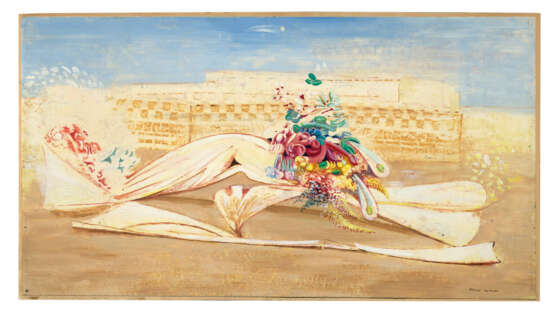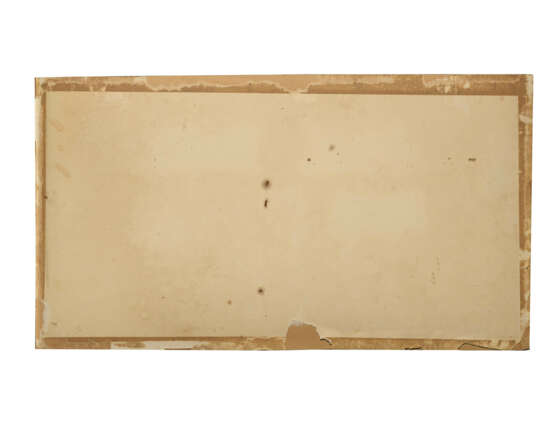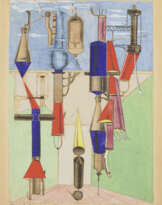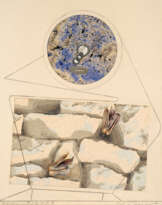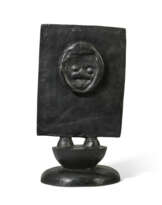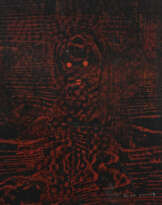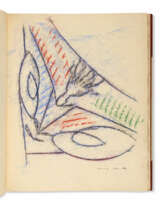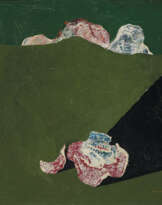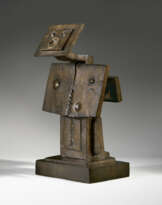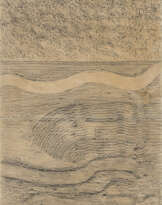ID 1053085
Lot 331 | Max Ernst (1891-1976)
Estimate value
€ 250 000 – 350 000
Jardin gobe-avions
signé 'max ernst' (en bas à droite)
gouache et frottage sur papier
27.6 x 50.8 cm.
Exécuté en 1935
signed 'max ernst' (lower right)
gouache and frottage on paper
10 7⁄8 x 20 in.
Executed in 1935
Provenance
Joseph-Berthold et Gaëtane Urvater, Bruxelles (avant 1953 et jusqu'à au moins 1966).
Galleria Galatea, Turin (avant 1966).
Giulio Einaudi, Turin (avant 1969 et jusqu'à au moins 1979).
Galleria Galatea, Turin.
Acquis auprès de celle-ci par le propriétaire actuel dans les années 1980.
Literature
P. Waldberg, Max Ernst, Paris, 1958, p. 291 (illustré; daté '1934').
J. Russell, Max Ernst, Life and Work, Londres, 1967, no. 63, p. 346 (illustré, fig. 63; dimensions éronnées; décrit comme 'huile sur toile'; provenance éronnée).
M. Brion, 'Max l'oiseleur', in G. di San Lazzaro, éd., XXe siècle, Numéro spécial, Hommage à Max Ernst, 1971, p. 89 (illustré, daté '1934'; décrit comme 'peinture').
U. M. Schneede, The Essential Max Ernst, Londres, 1972, p. 212, no. 303 (illustré, p. 152).
W. Spies, S. et G. Metken, Max Ernst, Werke, 1929-1938, Cologne, 1979, p. 322, no. 2182 (illustré).
Exhibited
Knokke-Le Zoute, Casino Communal, Max Ernst, juillet-août 1953, p. 26, no. 68.
Bern, Kunsthalle, Max Ernst, août-septembre 1956, no. 58.
Otterlo, Museum Kröller-Müller et Liège, Musée des Beaux-Arts, Les Grandes collection belges, Collection Urvater, juin-novembre 1957, no. 37 (illustré; décrit comme 'peinture sur papier').
Leicester, Museum and Art Gallery; York, City of York Art Gallery et Londres, Tate Gallery, Paintings from the Urvater collection, septembre-décembre 1958, no. 28.
Paris, Musée National d'Art Moderne, Max Ernst, novembre-décembre 1959, no. 53 (décrit comme 'huile sur papier').
Turin, Galleria Galatea, Max Ernst, octobre-novembre 1966, no. 20 (illustré; daté '1934').
Stockholm, Moderna Museet, Max Ernst, Màlningar, collage, frottagen teckningar, grafik, böcker, skulpturer, 1917-1969, septembre-novembre 1969, p. 75, no. 54 (illustré, p. 55).
Amsterdam, Stedelijk Museum, Max Ernst, novembre 1969-janvier 1970, no. 52.
Stuttgart, Württembergischer Kunstverein, Max Ernst, Gemälde, Plastiken, Collagen, Frottagen, Bücher, janvier-mars 1970, p. 148, no. 63, (illustré, p. 113).
Further details
Exécuté en 1935, Jardin gobe-avions provient d'une série de toiles habitées d'étranges formes végétales qui viennent envahir des débris d'engins volants, échoués au cœur de paysages désertiques. Dans cette douzaine de tableaux énigmatiques de Max Ernst dont les horizons désolés rappellent ses collages du début des années 1920, les « gobe-avions » du titre surgissent par grappes : feuilles, pétales, tiges et bourgeons luxuriants scintillent comme des joyaux sous les rayons d'un soleil absent. Comme la plupart des surréalistes, Ernst avait une fascination profonde pour les manifestations les plus singulières et troublantes de la nature : de la sexualité cannibale de la mante religieuse à l'apparence douce et inoffensive de plantes carnivores telles que l'attrape-mouches de Vénus. À la fois hostile et attrayante, la flore de Jardin gobe-avions revêt cette même ambiguïté. S'enroulant avec avidité autour des restes fragiles des avions, les jolies fleurs semblent enserrer la carcasse afin de l'immobiliser, la clouant au sol pour mieux la dévorer.
Cette idée de l'avion piégé est peut-être dérivée d'un texte du début du XIXe dont Ernst conservait un exemplaire dans sa bibliothèque : Aviceptologie Française, ou traité général de toutes les ruses dont on peut se servir pour prendre les oiseaux de C. J. Kresz. Paru en 1820, ce singulier guide pratique à l'intention des amateurs d'oiseaux chanteurs renfermait des illustrations des divers pièges et appâts que pouvait fabriquer artisanalement le chasseur afin de capturer sa proie. Dans Jardin gobe-avions, Ernst joue à renverser le rapport entre victime et prédateur, en imaginant un monde dans lequel des créatures végétales aux couleurs vives et affriolantes attendent sournoisement que passent d'innocents appareils volants pour les attirer vers leur perte. Pour Ernst, qui s'était battu sur le front de la Grande Guerre, cette inversion des rôles était d'autant plus percutante que l'avion était intimement lié, dans son esprit, à l'image de la mort et de la destruction. Ici, ce sont les épaves éventrées, brisées par l'impact de la chute, qui étouffent sous l'étreinte meurtrière des vrilles. Leurs fines coques de métal semblent se plier et se gondoler sous le poids des fleurs affamées qui mettent la machine hors d'état de nuire.
Pris dans leur ensemble, les tableaux de la série donnent à voir une progression : les plantes prédatrices poussent, se multiplient et se diversifient d'une toile à l'autre, et l'environnement répond en s'adaptant graduellement à ce nouvel ordre naturel. Au gré des scènes, Ernst élabore des « jardins » aux structures de plus en plus complexes, compartimentés selon une géométrie toujours plus trompeuse, qui finit par former des labyrinthes sans issues possibles pour les proies ailées. Dans cette composition-ci, les cloisons sont encore discrètes : suggérées, seulement, par cette construction fantomatique qui se dresse comme un mirage en toile de fond. Proche des édifices en escalier de la série La Ville entière (dont elle partage le rendu et la texture, très probablement obtenus par l'emblématique technique de « grattage » de l'artiste), ici, la mystérieuse architecture évoque davantage l'enfermement que la promesse d'un refuge, intensifiant l'atmosphère inquiétante de la scène. En ce sens, les Jardin gobe-avions préfigurent les monstrueuses jungles que peindra Ernst dès la fin des années 1930, où des herbes envahissantes, entremêlées de formes griffues et d'effrayantes créatures, semblent menacer le monde des hommes.
L'une des quelque douze variations sur le thème saugrenu, angoissant du Jardin gobe-avions, cette œuvre conservée dans la même collection particulière depuis un demi-siècle est aujourd'hui offerte aux enchères pour la toute première fois.
Executed in 1935, Max Ernst’s Jardin gobe-avions (Garden Airplane-Traps) hails from the artist’s enigmatic series of paintings in which strange, colourful plant-like forms engulf the remains of a collection of flying machines that have fallen to the earth. In these dozen or so paintings, the titular ‘airplane traps’ spring from a desolate landscape reminiscent of Ernst’s early 1920s collages, their luscious bundles of brightly coloured fronds, buds, vines and flowers sparkling like jewels within the desert-like environment, glimmering in the light of an unseen sun. Ernst and his fellow Surrealists shared a deep fascination for the bizarre and uncanny characteristics of the natural world, from the cannibalistic sexual practices of the praying mantis, to the seemingly innocuous appearance of predatory plants such as the Venus fly trap. At once highly attractive and eerily threatening, the flowers in Jardin gobe-avions appear to exhibit similar characteristics, their bold, richly variegated blooms wrapping themselves hungrily around the delicate armature of the fragmented planes, ensnaring them in such a manner as to completely disable their flying capabilities, rooting their forms once again to the earth in order to consume them.
The artist may have been drawn to the concept of trapping airborne creatures by an early nineteenth-century treatise by C. J. Kresz, Aviceptologie Française, ou traité général de toutes les ruses dont on peut se servir pour prendre les oiseaux, a copy of which Ernst held in his personal library. Dating from 1820, the book gave detailed instructions as to the best methods of capturing song birds, and included illustrations of the various mechanical man-made traps the hunter could construct, each one created with the sole purpose of luring and snaring their prey with the utmost efficiency. In Jardin gobe-avions Ernst appears to play with this concept, subverting the relationship between predator and prey by creating a scenario in which the organic plant forms lie in wait for the unsuspecting, mechanical aircraft to pass overhead, drawing them to their doom with the dazzling hues of their blooms. For the artist this inversion of power dynamics was particularly striking, as the airplane had been so intertwined with destruction and death in his imagination, ever since his experiences of aerial warfare during the First World War. Here, the bodies of these flying machines are torn asunder by the force of a crash landing and the tendrils of the plants that ensnare them, fractured into thin strips of metal that fold and twist like paper under the weight of the encroaching carnivorous plants, their threatening nature neutralised in an instant.
Considered together, the paintings in the Jardin gobe-avions series explore the evolution of not only these strange, predatory plants, their forms growing, multiplying and diversifying from picture to picture, but also the gradual adaptation of the surrounding environment in response. Indeed, as the series developed, Ernst’s ‘gardens’ also became increasingly complex in structure, divided into strange, geometric compartments that appear connected in an impossible maze, closing off any possible escape routes for the flying machines. In the present composition, however, these walls are merely suggested and hinted at, denoted by a ghostly structure that rises behind the debris of the airplane, almost like a mirage within the desert landscape. Showcasing similarities with the stepped structures of the artist’s La ville entière paintings in texture and effect, most likely achieved through his favoured grattage technique, this form suggests containment rather than shelter, adding to the disquieting atmosphere of the scene. As such, the Jardin gobe-avions series may be seen to lead directly into the monstrous, untameable wild jungles that marked Ernst’s compositions of the late 1930s and 1940s, where dense groves of foliage, flowers and vines interspersed by claw-like forms and unsettling hybrid creatures threaten the world of man.
One of only a dozen paintings created by Ernst of this enigmatic, menacing subject, the present Jardin gobe-avions appears at auction for the first time in its history, having remained in the same private collection for the last fifty years.
| Artist: | Max Ernst (1891 - 1976) |
|---|---|
| Applied technique: | Gouache |
| Artist: | Max Ernst (1891 - 1976) |
|---|---|
| Applied technique: | Gouache |
| Address of auction |
CHRISTIE'S 9 Avenue Matignon 75008 Paris France | ||||||||||||||
|---|---|---|---|---|---|---|---|---|---|---|---|---|---|---|---|
| Preview |
| ||||||||||||||
| Phone | +33 (0)1 40 76 85 85 | ||||||||||||||
| Fax | +33 (0)1 40 76 85 86 | ||||||||||||||
| Conditions of purchase | Conditions of purchase | ||||||||||||||
| Shipping |
Postal service Courier service pickup by yourself | ||||||||||||||
| Payment methods |
Wire Transfer | ||||||||||||||
| Business hours | Business hours
|

